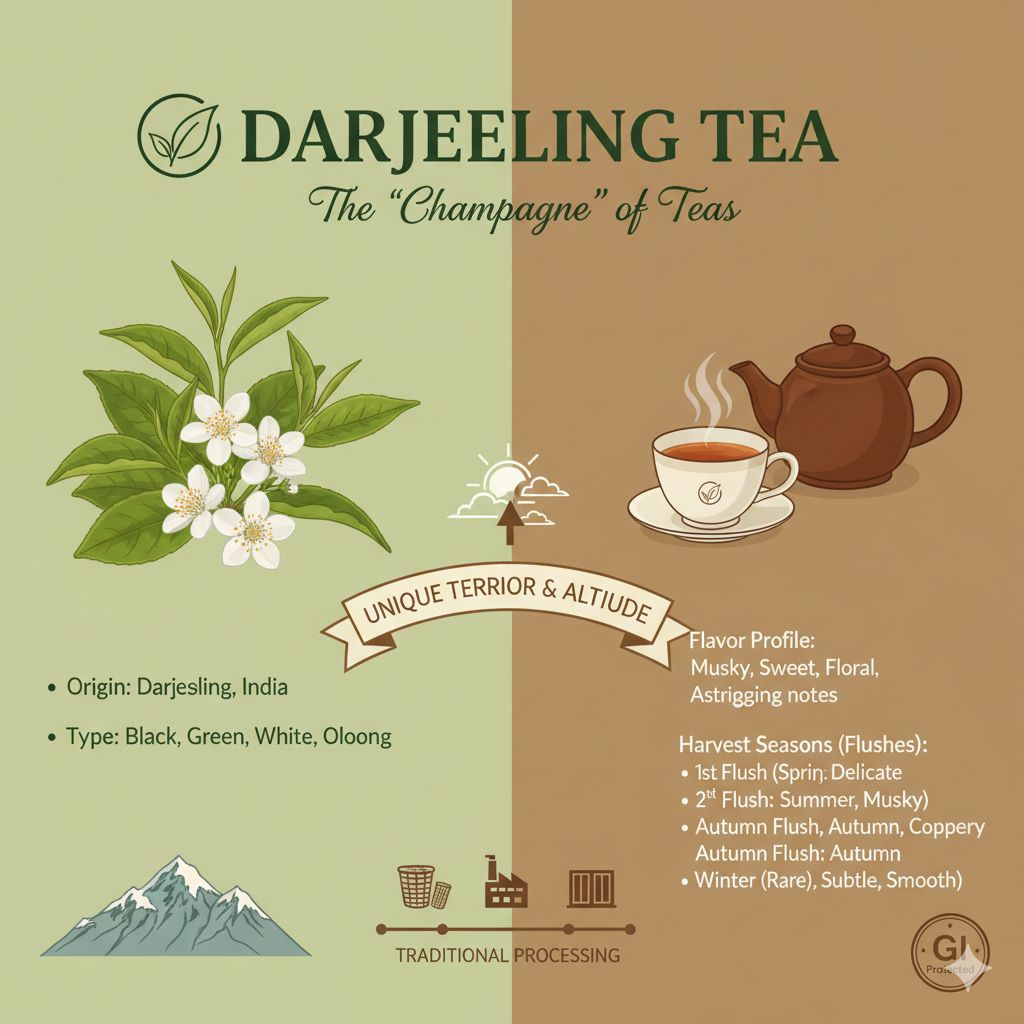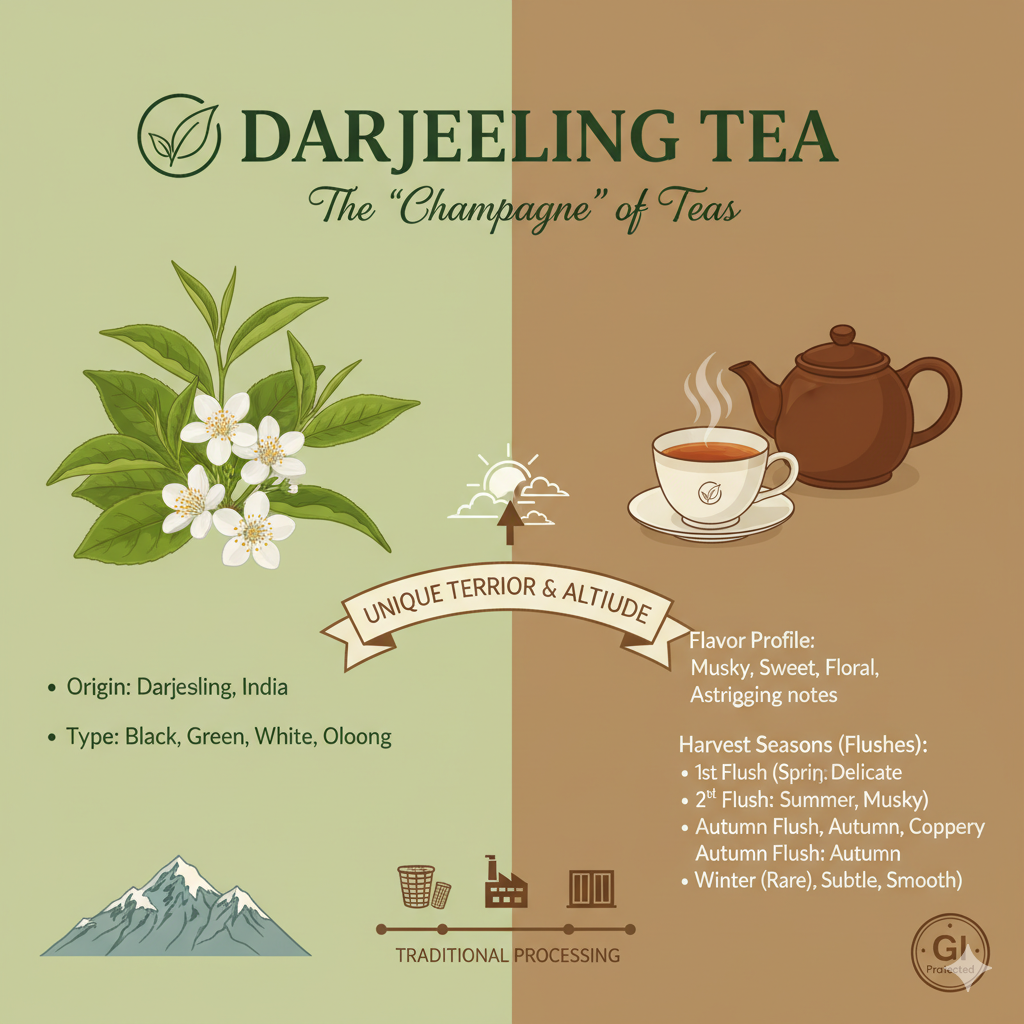Hey there, tea lover! If you’ve ever sipped a cup that feels like a gentle mountain breeze, chances are it was Darjeeling tea. Grown high in the misty hills of India, this brew stands out for its light, floral notes and subtle complexity. Often dubbed the “champagne of teas,” it’s a favorite among those who appreciate something refined yet approachable.
Let’s dive into what makes this Himalayan delight so special, from its roots and seasonal flavors to the vibrant festivals that celebrate its heritage.
The Himalayan Origin and Rich History
Picture this: rolling slopes at 2,000 meters elevation, where cool air and rich soil create magic. The origin of Darjeeling tea traces back to the 1800s, when British colonists planted Chinese tea seeds in West Bengal’s Darjeeling district. By the mid-19th century, estates flourished, kickstarting the production that would make it a global icon.
Why is Darjeeling tea called the “champagne of teas?
” It’s all about that exclusive terroir—unique flavors derived from the high-altitude mists and specific climate, much like France’s bubbly.
Exploring Darjeeling Tea Estates
Darjeeling tea estates in West Bengal, like Makaibari, Risheehat, and Jungpana, are the heart of it all. These family-run spots, some over 150 years old, focus on hand-picking leaves for top quality. Many estates today emphasize sustainable farming practices, using organic methods, rainwater harvesting, and drought-tolerant plants to combat climate challenges. Visiting during a harvest feels like stepping into a postcard—lush greens and dedicated workers ensuring every batch is pure.
Understanding Flushes: The Seasonal Difference
Darjeeling’s seasons define its taste through what are called “flushes” or harvests.
The difference is striking and what makes Darjeeling so versatile:
Flush Season Flavor Profile First Flush Spring (March-April) Light, vibrant, with grassy and floral hints. The most delicate. Second Flush Summer (May-June) Fuller body, with a famous, pronounced muscatel (grape-like) richness. Autumn Flush Autumn (October-November) Coppery cup color with airy, slightly fruity notes. A balanced, mellow flavor. Beyond black tea, explore rare Darjeeling varieties like Moonlight or Silver Needle white teas, which are minimally processed for a sweet, subtle glow. Additionally, Darjeeling oolong tea is a semi-oxidized gem known for its aid in digestion due to gentle enzymes.
How to Brew Darjeeling Tea Perfectly 🍵 Ready to steep your cup of elegance?
Since Darjeeling’s nuances are delicate, proper brewing is key. Brewing Instructions for First Flush Tea
- Water Temperature: 85^\circ\text{C} (just off the boil).
- Tea Leaves: 1 teaspoon of leaves per cup.
- Steep Time: 2-3 minutes max for that golden balance.
- Tip: Skip the milk! The best way to prepare Darjeeling black tea is plain to fully savor its complex, subtle flavor.
For Darjeeling green tea brewing instructions, go even cooler, around 80 to avoid any bitterness.
Health Benefits of Darjeeling Tea and Beyond
Darjeeling tea isn’t just a treat for the palate; it offers notable wellness benefits too! - Antioxidants: It’s packed with polyphenols that fight free radicals and give your immunity a gentle boost.
- Weight Management: Its catechins can help rev up your metabolism, making it a healthy swap for sugary drinks if you’re aiming for weight loss.
- Skin & Hair: Relief from oxidative stress may promote a healthy glow and help reduce premature aging.
Celebrating the Heritage: Darjeeling Tea Festivals 🎉
For a truly immersive experience, plan your visit around one of the region’s vibrant tea festivals, which blend culture, flavor, and heritage.
- Teesta Tea and Tourism Festival
This premier event is one of Darjeeling’s most vibrant, typically held in late fall (November/December), though dates can shift.
- Highlights: Extensive tea tastings (black, green, white, oolong, masala), guided garden tours showcasing sustainable farming, and cultural performances reflecting Gorkha and Lepcha heritage.
- Vibe: A blend of tea appreciation and general tourism, often spanning Darjeeling and the Teesta River valley.
- Darjeeling Tea Festival
This gathering is focused purely on the tea itself and usually occurs during the warmer summer months (May-July), aligning with the prized Second Flush harvest.
- Highlights: Expert-led sessions on brewing and flavor profiles, specific tastings paired with local sweets, and in-depth discussions on organic practices and sustainability.
- Vibe: Ideal for the serious tea enthusiast looking for a deeper dive into tea culture.

- Darjeeling Hill Marathon & Melo-Tea Festival
A unique multi-day extravaganza that fuses fitness, music, and tea, often held in December.
- Highlights: A competitive marathon (21K/10K) through the hilly terrain, significant music events with local and international artists, and a variety of cultural events like a kite festival, village tourism, and of course, tea tastings!
- Vibe: A community-focused festival promoting adventure, sports, and cultural unity alongside tea heritage.
Where to Buy Authentic Darjeeling Tea Online
To ensure you’re getting the genuine article, especially a fresh flush, look for reputable brands. - Recommended Brands (often available online): Golden Tips, Teabox, and Vahdam.
- What to Look For: Authenticity is ensured when the tea carries a GI tag (Geographical Indication). Check specialized tea retailers like Thunderbolt Tea for fresh flushes and subscription options. Prioritize buying from brands that support sustainable farming practices.
There you have it—a heartfelt guide to Darjeeling’s charm. Whether you’re chasing wellness or just a peaceful moment, this tea delivers. Grab a pack, brew up, and let the Himalayas whisper in your cup! 🏔️



